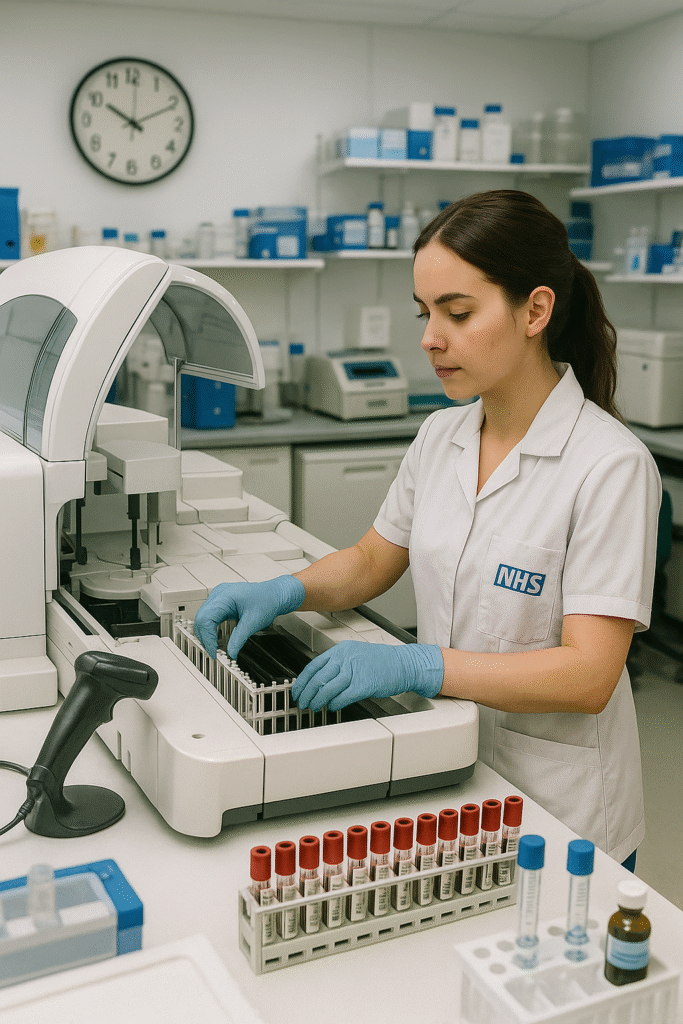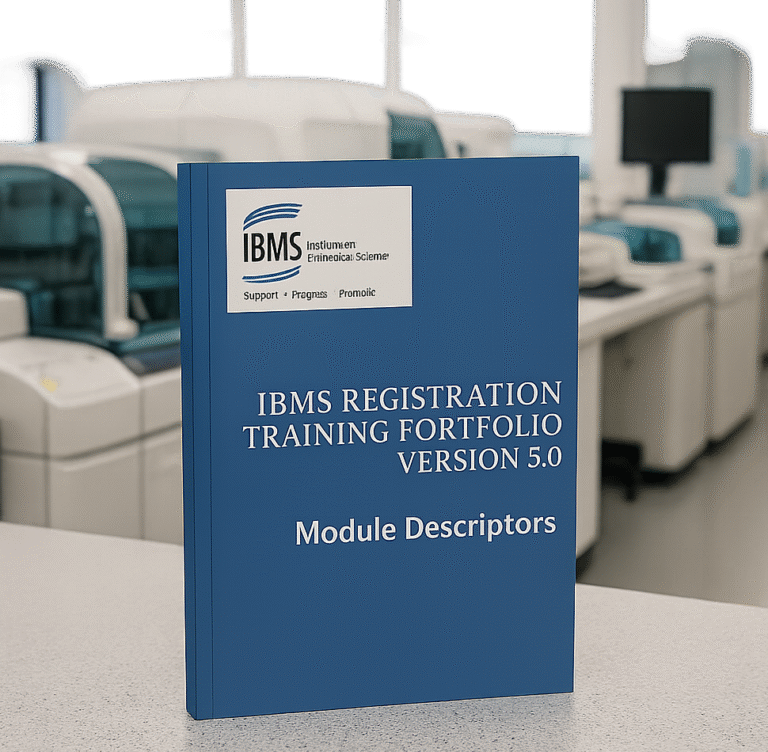Discover what a typical day looks like for a Band 5 Biomedical Scientist in the NHS—from sample testing to analyser checks and patient-impacting results.
By Ayyaz Ahmad – Deputy Training Lead, Specialist Biomedical Scientist
If you’re considering a career in biomedical science or are about to begin your first role as a Band 5 Biomedical Scientist (BMS), you might be wondering—what does a typical day actually look like?
This post offers a realistic, detailed insight into the daily duties, challenges, and rewards of working in this entry-level BMS role within the NHS. From sample processing to quality control, here’s what a “day in the life” really involves.
1. What is a Band 5 Biomedical Scientist?
In the UK, NHS roles are classified using the Agenda for Change banding system.
A Band 5 Biomedical Scientist is typically a newly HCPC-registered professional who has successfully completed the IBMS Registration Training Portfolio. This is the entry-level position for qualified BMS staff and serves as a gateway into specialisation and career progression (e.g. Band 6 Specialist BMS roles).
2. Starting the Shift: The Morning Routine
Most Band 5 BMSs work either early, core, late, or night shifts depending on the department’s rota system. Let’s assume a typical 09:00 am – 5:00 pm core shift in a Clinical Chemistry lab.
Morning Duties:
- Arrive on time, don lab coat and check staff rota.
- Attend morning briefing or handover to learn about any issues from the previous shift.
- Log into the LIMS (Laboratory Information Management System) and check for urgent or priority samples—like those from A&E or ITU.
- Perform daily equipment checks and quality control (QC) on analysers to ensure they are functioning within acceptable ranges.
- Run IQC material and document results. If QC fails, escalate to senior staff.
3. Sample Reception and Registration
Biomedical Scientists may rotate through different lab sections. In sample reception:
- Receive blood, urine, and other body fluid samples.
- Check patient details and request forms for accuracy.
- Register samples onto LIMS, barcoding and sorting them for processing.
Efficient sample triaging is critical to maintaining turnaround times (TATs), especially for urgent inpatient tests.
4. Running and Monitoring Laboratory Analysers
Once samples are registered:
- Load samples onto automated analysers (e.g. Roche cobas, Abbott Architect, Abbott Alinity).
- Monitor workflow and instrument status continuously.
- Troubleshoot instrument flags, clot errors, or result anomalies.
- Validate results and release them to clinical teams if within expected parameters.
Band 5 BMSs are supervised but are still accountable for ensuring accuracy. Critical results (e.g. hyperkalaemia, low glucose) are phoned through to clinicians following SOP.
5. Liaising with Clinical Teams
Communication is key:
- Answer phone calls from wards and GPs chasing urgent results.
- Respond to queries about test availability or sample requirements.
- Escalate complex clinical discussions to a Band 6 or Clinical Scientist.
Effective communication supports safe and patient-centred care.
6. Midday Break and Reflection
Around midday, there’s usually a scheduled 30 minute break:
- A chance to have lunch and decompress.
- Often used by Band 5s to catch up on portfolio reflections, complete CPD logs, or discuss progress with a mentor or trainer.
7. Afternoon Tasks and Additional Duties
Afternoons may involve:
- Continuing sample analysis and result verification.
- Performing maintenance and calibration of analysers.
- Participating in audit tasks, SOP reviews, or updating reagent inventory.
- Training or shadowing across other lab sections to broaden experience (e.g. Immunology, Haematology, Transfusion).
Some Band 5s also start preparing for their Specialist Portfolio, which is the next step in professional development
8. End of Shift and Handover
Before finishing for the day:
- Check that all urgent samples have been processed.
- Document any unresolved issues or analyser faults.
- Provide a handover to the late shift staff to ensure continuity of service.
- Clean down workstations and equipment.
9. Challenges in the Role
Being a Band 5 BMS comes with responsibility:
- Dealing with unpredictable workloads during busy periods.
- Managing analyser errors under time pressure.
- Navigating communication challenges with clinical teams.
- Balancing training, CPD, and service delivery.
However, these challenges help build confidence, competence, and clinical judgement—all vital for progression.
10. Why This Role Matters
The results generated by Biomedical Scientists influence 70–80% of clinical decisions. A Band 5 BMS plays a pivotal role in patient diagnosis, treatment monitoring, and emergency response.
Whether it’s identifying critical electrolyte imbalances, screening for infection, or ensuring blood transfusion compatibility, the work truly makes a difference.
11. Top Tips for New Band 5 Biomedical Scientists
- Stay organised and write everything down—especially for audits and training evidence.
- Ask questions—senior staff expect it and are there to support you.
- Familiarise yourself with SOPs, local policies, and HCPC SoPs.
- Be open to constructive feedback—it’s part of your learning.
- Document CPD regularly and consider joining the IBMS for career guidance and resources.
12. Final Thoughts
Working as a Band 5 Biomedical Scientist is both a rewarding and developmental stage in a biomedical career. It’s the point where theory meets practice—and your scientific knowledge becomes essential to real-world healthcare.
Whether you’re processing urgent samples, maintaining analyser performance, or contributing to multidisciplinary teams, your role directly impacts patient safety and clinical outcomes.
And remember—every Senior Biomedical Scientist or Lab Manager started as a Band 5. Your journey is just beginning.
Want more career stories and insights?
Explore more posts on LabPathPro.com
Sign up for free class
It’s easy and free!









